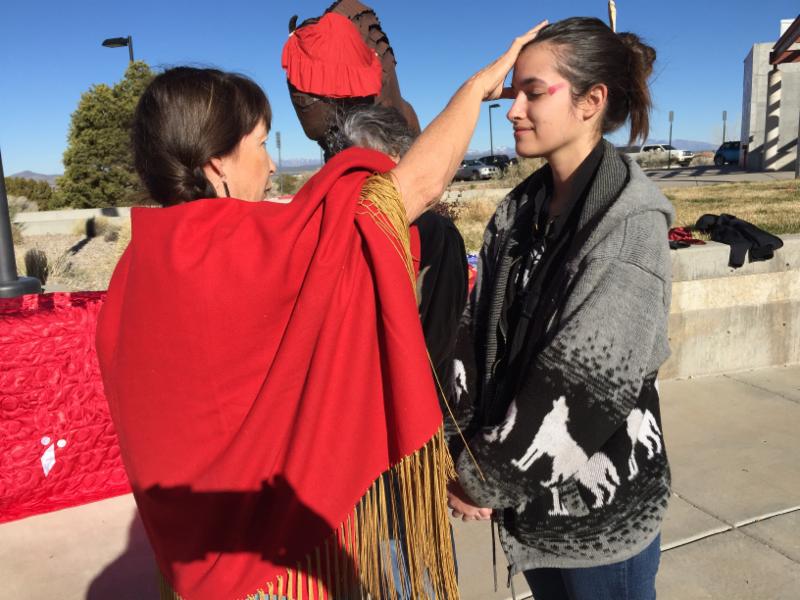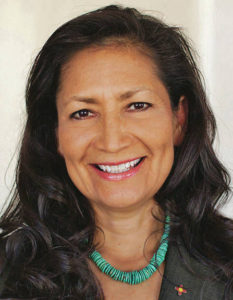
- Details
- By Deb Haaland
What would you do if your sister, your daughter or your mother went missing without explanation? There would be search parties. Law enforcement would issue amber alerts. Investigations would begin. Suspects would be brought in for questioning.
 Rep. Deb HaalandIn Indian country, that’s not the case. In Indian country, it is often days before law enforcement shows up for a missing person call or homicide. In the case of Ashlynne Mike, a eleven-year-old-girl in New Mexico, an amber alert wasn’t issued for more than 10 hours, when typically for cases of missing children those alerts are posted almost immediately. Ashlyn Mike lost her life at the age of eleven. In Indian country, families sometimes wait days for the authorities to respond, and frequently lead the only search parties. What’s worse, sometimes the record of that missing indigenous person isn’t documented, leaving questions unanswered for decades, leading to gaps in information, missing person cases unsolved and perpetrators roaming the streets.
Rep. Deb HaalandIn Indian country, that’s not the case. In Indian country, it is often days before law enforcement shows up for a missing person call or homicide. In the case of Ashlynne Mike, a eleven-year-old-girl in New Mexico, an amber alert wasn’t issued for more than 10 hours, when typically for cases of missing children those alerts are posted almost immediately. Ashlyn Mike lost her life at the age of eleven. In Indian country, families sometimes wait days for the authorities to respond, and frequently lead the only search parties. What’s worse, sometimes the record of that missing indigenous person isn’t documented, leaving questions unanswered for decades, leading to gaps in information, missing person cases unsolved and perpetrators roaming the streets.
Leona Kinsey disappeared from her home in Oregon 20 years ago – her car was found empty, purse in her home, groceries still in the fridge. She is still missing, and her family still wonders what happened to her.
What we do know is women and girls are disappearing without warning. What we do know is Native women face murder rates that are 10 times higher than the national average. What we do know is that families are left without answers. What we do know is there is a lot we do not know.
Indian country has been severely underfunded for decades. It leads to a lack of funding for roads, cellphone service and public safety departments.
There are several things we can do right away to begin addressing the crisis of missing and murdered indigenous women. First, we must adequately fund tribal law enforcement and victim advocates so survivors of domestic violence and trafficking do not become part of the statistics that contribute to loss of life. With the resources to hire more officers in Indian country and provide the proper training on missing person cases, law enforcement can improve response times and conduct effective investigations.
The picture can be even more dire for urban Indians. Recent reports by the Urban Indian Health Institute identified 506 cases of missing and murdered indigenous women across 71 urban cities – my state of New Mexico ranked number one for the highest number of MMIW cases with 78. These numbers are believed to be an extremely low estimate due to the lack of programmatic resources across the board to address issues of missing and murdered indigenous people in urban locations.
Due to devastating federal policies like forced relocation and removal over generations, 71 percent of the Native American population live in urban areas. Cities with high populations of Native Americans include places like Phoenix and Seattle and – my district – Albuquerque. That means communicating and sharing information, so that these cases can be tracked is critical, but right now communication between jurisdictions is limited and often times non-existent.
Three transgender Native people, Ryan Shey Hoskie, Fredrick Watson and Teri Benally, all in different stages of their lives – 23, 32, and 42 – were found beaten to death in Albuquerque between 2005 and 2009. The circumstances surrounding their deaths remain a mystery.
City, county, state and tribal agencies must work together so we can fully understand the scope of this epidemic. If unaddressed, Native people will continue slipping through the jurisdictional cracks.
We must commit as a country to the principle that every person deserves justice – every person deserves the same attention when they go missing, regardless of whether they are located in rural or urban areas, Native or an immigrant, rich or poor. I’m challenging my colleagues and law enforcement around the county to commit to that effort.
The epidemic of missing and murdered indigenous women has been overlooked for far too long, but we’re finally giving a voice to this silent crisis. When your community is at risk – when it could be your daughter, your sister or your mom – the issue demands urgency. The attention this issue has received wouldn’t have been possible without the women in Indian country saying, “enough is enough, we deserve to feel safe too”. It was a call for Congress to direct real resources to the problem.
We finally have political voices to raise this issue on the national level. That’s why I’m fighting for Savana’s Act, and to ensure protections for Native people are included in the Violence Against Women Act.
The cases of Leona Kinsey, Ashlyn Mike, Shey Hoskie, Fredrick Watson and Teri Benally could have been different. We must act in order to change this deadly cycle in Indian country.
Deb Haaland represents the New Mexico's 1st Congressional District in the 116 Congress. Elected in November 2018, she is one of the first two American Indian women to serve in Congress.
More Stories Like This
Extending the Affordable Care Act Is a Moral Imperative for Indian CountryAll Is Fair in … War?
Why Federal Health Insurance Policy Matters to Cherokee Nation
The Absence of October's Job Report Shows Why Native American Communities Need Better Data
Tribal IDs Are Federally Recognized. ICE Agents Are Ignoring Them.
Help us defend tribal sovereignty.
At Native News Online, our mission is rooted in telling the stories that strengthen sovereignty and uplift Indigenous voices — not just at year’s end, but every single day.
Because of your generosity last year, we were able to keep our reporters on the ground in tribal communities, at national gatherings and in the halls of Congress — covering the issues that matter most to Indian Country: sovereignty, culture, education, health and economic opportunity.
That support sustained us through a tough year in 2025. Now, as we look to the year ahead, we need your help right now to ensure warrior journalism remains strong — reporting that defends tribal sovereignty, amplifies Native truth, and holds power accountable.
 The stakes couldn't be higher. Your support keeps Native voices heard, Native stories told and Native sovereignty defended.
The stakes couldn't be higher. Your support keeps Native voices heard, Native stories told and Native sovereignty defended.
Stand with Warrior Journalism today.
Levi Rickert (Potawatomi), Editor & Publisher
